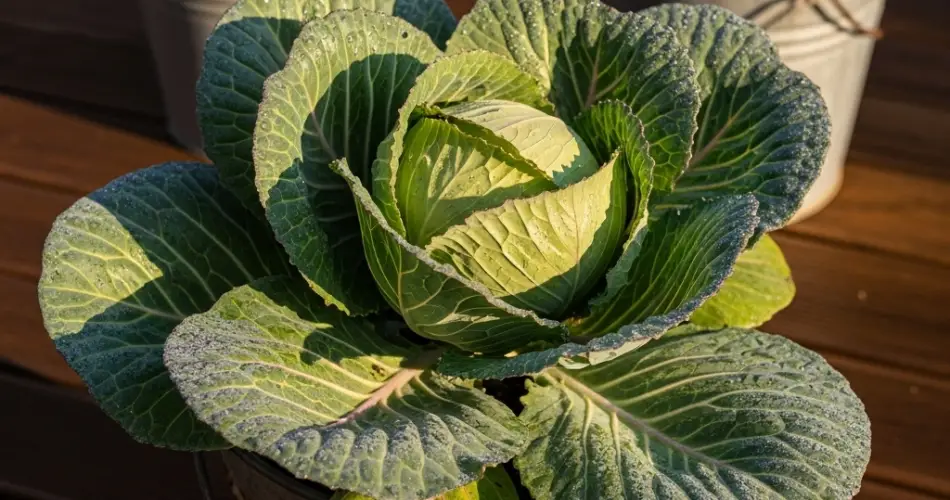Cabbage is a nutrient-packed vegetable that thrives in a variety of growing conditions, including containers. For urban gardeners, balcony growers, or anyone with limited space, cultivating cabbage in small buckets offers an excellent way to enjoy fresh, homegrown produce. With proper soil preparation, watering, sunlight, and care, even compact setups can yield large, healthy cabbage heads. This guide provides practical tips to maximize your bucket-grown cabbage harvest.
Why Grow Cabbage in Buckets?
Growing cabbage in buckets has several advantages. Containers give you control over soil quality, drainage, and nutrient levels, which is essential for producing dense, flavorful heads. Bucket gardening reduces exposure to soil-borne diseases, prevents pest infestations, and minimizes competition from weeds. Additionally, container-grown cabbage can be easily relocated to optimize sunlight exposure or protect plants from harsh weather conditions, making it ideal for small-space and urban gardening.
Choosing the Right Buckets
Selecting an appropriate container is critical for growing healthy cabbage. Cabbage plants have relatively shallow but wide root systems, so a bucket at least 12–14 inches deep and 12–16 inches in diameter is ideal for a single plant. Larger varieties may require slightly deeper or wider containers to allow for proper head formation. Plastic or food-grade buckets are lightweight and portable, while clay or ceramic pots provide stability. Ensure the bucket has sufficient drainage holes at the bottom to prevent waterlogging, which can hinder growth and promote root rot.
Preparing the Soil Mix
Cabbage thrives in nutrient-rich, well-draining soil. A fertile soil mix encourages healthy leaves and supports dense head formation. A recommended bucket soil mix includes:
-
50% loamy garden soil or topsoil: Provides structure and essential minerals.
-
30% compost or well-rotted organic matter: Enhances fertility, retains moisture, and supports microbial activity.
-
20% perlite, coarse sand, or vermiculite: Improves drainage and prevents soil compaction.
Mix thoroughly and lightly moisten the soil before planting. Avoid heavy clay soils, as they can retain excess water, restrict root growth, and reduce cabbage quality. Well-prepared soil ensures strong roots, robust growth, and the development of large heads.
Planting Cabbage
Cabbage can be grown from seeds or transplants. For seedlings, plant them at the same depth they were growing previously, spacing one plant per bucket. Proper spacing is essential to prevent overcrowding, which can lead to smaller heads and reduced airflow, increasing the risk of disease. For succession planting, consider starting seedlings every few weeks to enjoy a continuous harvest throughout the season.
Sunlight and Growing Conditions
Cabbage thrives in full sun, requiring at least six hours of direct sunlight daily. Containers can be strategically placed to ensure optimal light exposure, which promotes robust growth and dense head formation. Cabbage prefers cooler temperatures, making early spring or fall plantings ideal in many regions. Buckets allow you to move plants as needed to protect them from extreme heat or frost.
Watering and Mulching
Consistent moisture is crucial for container-grown cabbage. Buckets dry out faster than garden soil, so check moisture levels regularly and water deeply to keep the soil evenly damp. Avoid waterlogging, which can promote root rot and fungal issues. Mulching with straw, shredded leaves, or other organic materials helps retain soil moisture, regulate temperature, and reduce weed growth. Proper watering and mulching support strong root systems and healthy, large heads.
Fertilization and Nutrient Management
Cabbage is a heavy feeder that requires adequate nutrients to form dense heads. Incorporate a slow-release organic fertilizer or compost into the soil at planting. During the growing season, supplement with liquid fertilizer or compost tea every two to three weeks. Focus on nitrogen early for leafy growth, then balance with phosphorus and potassium to encourage head development. Avoid excessive nitrogen later in growth, as it can produce lush foliage but smaller heads.
Pest and Disease Management
Container-grown cabbage is less prone to pests than garden-grown plants but may still face occasional issues. Common pests include aphids, cabbage worms, and flea beetles, while diseases like downy mildew can affect leaves. Inspect plants regularly, remove damaged leaves, and use organic pest control methods when needed. Proper spacing, well-draining soil, and consistent care reduce most problems.
Harvesting Cabbage
Cabbage heads are typically ready to harvest 70–100 days after planting, depending on the variety. Harvest when the heads are firm and fully formed. Use a sharp knife to cut the head at the base, leaving the outer leaves intact if you plan to allow smaller side shoots to grow. Timely harvesting ensures peak flavor, crisp texture, and encourages potential regrowth of additional leaves or side heads.
Conclusion
Growing cabbage in buckets is a practical and rewarding approach for gardeners with limited space. By selecting suitable containers, preparing nutrient-rich, well-draining soil, providing adequate sunlight and water, and managing nutrients, pests, and spacing effectively, gardeners can produce large, healthy cabbage heads from small buckets. Container gardening offers flexibility, control, and high productivity, allowing urban gardeners to enjoy fresh, homegrown cabbage even in tight spaces. With attention to detail and consistent care, bucket-grown cabbage can yield a bountiful harvest of crisp, flavorful heads throughout the season.



